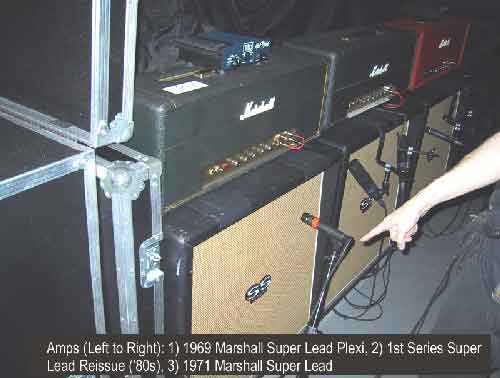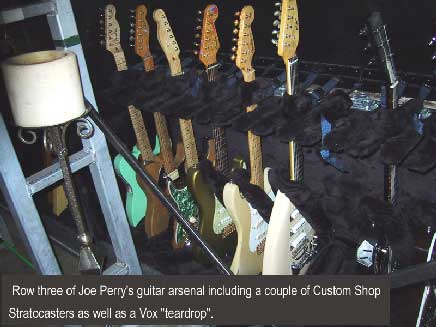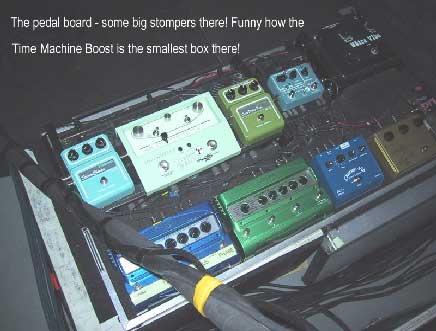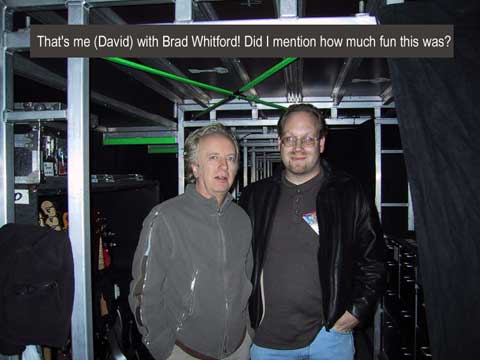This past November, I had the pleasure to attend the Aerosmith show at the Shoreline in the Bay Area, with the added treat of being able to go backstage in the tech area prior to the show to get the full lowdown on what else? – the gear! I have to thank Brad Whitford’s personal guitar tech, Greg Howard, as well as Brad himself for taking the time out to meet with me and chat.
The stage sound during the show was perfectly mixed and sounded great. Joe Perry and Brad Whitford’s setups were both for the most part straightforward and based around the use of some of the best vintage guitars and amps along with a limited use of effects.
Notes on the Amps
Both of the guitarist’s backlines feature vintage Marshall amps, with Brad’s choice being two Marshall 100 watt Super Leads while Joe chooses to go with vintage 200 watt Marshall  Majors. Since my invitation was from Greg Howard and not from Joe Perry’s tech Jim Survis, the majority of the focus and insight here will be on Brad’s setup.
Majors. Since my invitation was from Greg Howard and not from Joe Perry’s tech Jim Survis, the majority of the focus and insight here will be on Brad’s setup.
Brad takes a great approach that combines the pure fat tone of a guitar plugged straight into a Marshall and mixes that with a stereo wet signal running two other amplifiers and cabinets. The dry signal Marshall is an original 1969 100 watt “plexi” Super Lead. It is set with the channels “linked” in normal fashion, where the guitar runs into the top of the treble channel I and then links the bottom of that channel into the top of the bass-enhanced channel II.
 Brad runs a wireless system with one wireless unit going into the Marshall direct, while the other plugs into the pedal effects system, which then splits into stereo into two additional amplifiers and cabinets. The redhead amp pictured is a ’71 Marshall 100 watt Super Lead and is one of the amps used in this configuration. The second amp used which is kept in a rack, is an early Bogner Ecstacy. It is used for the plexi-voiced channel only. The middle Marshall amp head pictured with the other two is an early plexi reissue and is a backup amplifier.
Brad runs a wireless system with one wireless unit going into the Marshall direct, while the other plugs into the pedal effects system, which then splits into stereo into two additional amplifiers and cabinets. The redhead amp pictured is a ’71 Marshall 100 watt Super Lead and is one of the amps used in this configuration. The second amp used which is kept in a rack, is an early Bogner Ecstacy. It is used for the plexi-voiced channel only. The middle Marshall amp head pictured with the other two is an early plexi reissue and is a backup amplifier.
Both Marshalls run THD Hot Plate attenuators, which allows Brad to turn the amps up to get the warmer power tube saturation, while also maintaining a good comfortable listening level. In fact, it’s interesting to note that the drums were also “shielded” by plexiglass walls so as to not be overpowering the other instruments on stage. While Brad admits that he generally prefers a non-attenuated Marshall tone since a full-up Marshall allows the speakers to push harder for the best tone, the entire stage sound system was obviously carefully constructed to be sonically comfortable (which a non-attenuated Marshall is not unless you’re already deaf!!) and balanced for all the musicians onstage.
When asked about the typical settings used for the amps and the Hot Plates, Greg Howard replied, “The Marshalls are both run through 16ohm THD HotPlates set at -12db. The volumes on both channels are run at about 6. I’d say they achieve a medium saturation. Tones are set for a slightly bright tone, so as to not be woofy. Brad employs the ‘light touch, volume roll down technique’, as well as the ‘dig in hard for more grind technique’. Remember, this guy was doing it way before master volume was invented.”
Cabinets are all Bogners with Vintage 30 Celestions. Interestingly enough, notice the logos on the cabs – those are “SS 396” Chevrolet badges, as used on some of the greatest muscle cars of the late ‘60s. This “visual” clue is what directed me to ask some of my questions to Brad himself, not about gear, but about cars! It turns out we both have the same tastes in automobiles, the only difference being that Brad actually owns the many dream cars on my list including: a ’69 Z-28 Camaro, ’67 tri-power 427 Corvette, new Z06 Corvette, Dodge Viper, etc. And the SS badges are in homage to his love of his ‘60s Chevelles. But back to the gear…
Joe Perry also relies on a relatively simple-but-effective approach and runs a Marshall 200 watt Major head into two 4 x 12 cabs. An additional Major is on stage and serves as a backup. One of the cabinets he calls “Brad” and it is – you guessed it – some signal from Brad’s system. To ease the power strain on the Major’s circuitry a variable AC controller, i.e. VARIAC, is used to drop the voltage a bit (“but not to the point of squashing the signal too much,” says Howard). Power for both guitar systems goes through an extensive UPS and power conditioning rig. Last but not least, Joe mixes in a Gibson Goldtone amp that is on all the time and mixes with the tone of the Marshall.
Notes on the Guitars
The guitars backstage are numerous and Joe Perry’s arsenal alone topped over 30 instruments! There is an amazing variety of guitars backstage – from Les Pauls, V’s, Travis Beans, Stratocasters, a 10-string B.C. Rich, and even a Vox “teardrop” style guitar. These  aren’t just for display either – Joe Perry switches guitars after each song – a nice convenience to have with no worries about knocking a guitar out of tune with aggressive rhythm or lead playing and having to make due during a second song.
aren’t just for display either – Joe Perry switches guitars after each song – a nice convenience to have with no worries about knocking a guitar out of tune with aggressive rhythm or lead playing and having to make due during a second song.
While some of the guitars are custom shop variants of originals (both of Joe’s Stratocasters are from the Custom Shop), there are some notable original vintage guitars used as well, including one of Joe’s famous 1960 Les Paul Standards with a low production serial number. I didn’t dare ask to pick up or play that guitar, or any guitar for that matter, but was content just gazing at the “eye candy” and taking some nice pictures.
I asked about some of Brad’s favorite guitars and how they’re used, from which Greg answered: “Brad loves the Les Paul, he goes through phases where he leans on a particular  one. Be it the ’59 Historic w/Timbuckers, the Blue Sparkle Custom Shop with EMG’s, the Red Bigsby w/Tom Holmes, or the newly acquired ’75 Goldtop Deluxe w/mini hums… He also loves his Shoreline Gold Melancon Strat w/mid boost, and has commented on how he could do the entire show with that guitar. Also a constant is his McInturff Taurus and Hamer Korina Standard (Explorer), always used somewhere in the set. Basically, he has about 10 guitars he uses every show and he switches them up on different songs.”
one. Be it the ’59 Historic w/Timbuckers, the Blue Sparkle Custom Shop with EMG’s, the Red Bigsby w/Tom Holmes, or the newly acquired ’75 Goldtop Deluxe w/mini hums… He also loves his Shoreline Gold Melancon Strat w/mid boost, and has commented on how he could do the entire show with that guitar. Also a constant is his McInturff Taurus and Hamer Korina Standard (Explorer), always used somewhere in the set. Basically, he has about 10 guitars he uses every show and he switches them up on different songs.”
Greg said that he couldn’t really comment on Joe’s personal favorites since he isn’t his tech, but did state that Joe will use his ’60 Les Paul “more than once” during a show.
Notes on Effects
For Brad Whitford’s “wet” signal, he uses a number of effects either for stereo enhancement or for some boosting. Because he’s also running a straight Marshall signal,  the final tone result is a nice blend and balance between the wet and dry rigs and not an overpowering “wall of chorus” as can sometimes occur.
the final tone result is a nice blend and balance between the wet and dry rigs and not an overpowering “wall of chorus” as can sometimes occur.
For overdrive with added compression, Brad will stomp on either a Klon Centaur or a Maxon overdrive unit. When wanting a non-effected boosted signal to overdrive his Marshalls naturally, Brad uses none other than LegendaryTones’ own Time Machine Boost (little plug: www.robertkeeley.com). Different solos will call for different tones and Brad enjoys having a wealth of choices onboard to go to.
Other units include a Zvex Wah/Probe, SweetSound Ultravibe, Line6 DD4 Delay Modeler, Line6 MM4 Modulation Modeler, Danelectro Reel Echo, all connected with an ADL Juicebox Power Supply. A picture below shows his board.
Final Words
Again, I have to thank Greg Howard, who also runs www.pedalboard.com for allowing me to come out and meet with him and Brad Whitford and providing such great insight. The experience to get the info first-hand was wonderful and I hope it was of interest to the great readers here! Take care and Happy Holidays!
David Szabados 12/11/02
